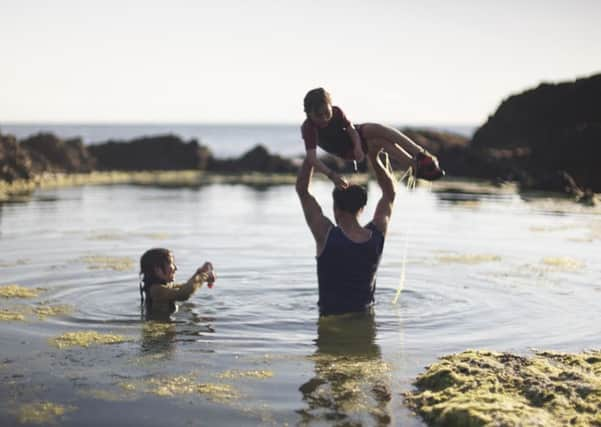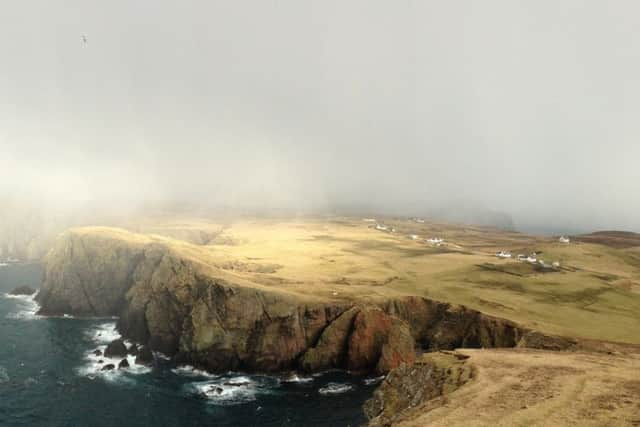Martyn McLaughlin: Fair Isle offers a lesson in the values of community


It can be a hard existence on the most remote inhabited island in Britain. Most visitors know only the summer, when a flaxen light lingers late into the night and days are spent baling and shearing amid wispy carpets of cottongrass. The approaching winter will banish such potent symbols of renewal as nature asserts her cruel side, cutting off the Good Shepherd IV ferry and eight-seater Islander plane for days, weeks even, at a time. The few who bear witness to this cycle embrace its challenges and rewards.
My wife was the last member of the Wilson family born on Fair Isle, one of the few remaining links to a surname stretching back twelve generations in the storied history of the island, situated halfway between the Shetland and Orkney archipelagos. She left with her parents and elder brother when she was just two. One of the mementos from that time is a black and white photograph of her sat in a timber fish box, bawling her heart out. It is not, I have been assured, a representative image of her early childhood.
Advertisement
Hide AdAdvertisement
Hide AdShe carved out her own life, first on the Shetland mainland, then with me in the central belt, but never lost touch with her birthplace. Neither did it forget her. When I arranged a surprise holiday to the island shortly after our marriage, the years fell away. Her return, however temporary, was treated as a homecoming. Our first evening spilled freely into our first morning, soundtracked by song and laughter. It was fulfilling to strengthen that bond. Our own little family was subsumed into a small yet widening circle, and we resolved to visit again before long. It was a promise we kept, even if the nature of our return came as a surprise.


The origin was an advertisement placed by the island’s owners, the National Trust for Scotland, letting out Barkland, a four-bedroom croft complete with 10 hectares of land and twice as many Shetland ewes. At the time, Fair Isle’s population had stooped perilously low. The trust hoped to find a new family to take over the property and buttress a community just 55 souls strong.
Our daughter was six months-old and the idea of beginning where my wife had left off exerted a strong emotional pull. We felt bound by symmetry and, for a few days, gave the application serious consideration. As time passed, however, sentimentality gave way to sober reflection. The clincher was the admission that if I could barely change a plug, what hope would I have of running a working croft?
Yet the idea refused to wither. If not us, then who? My innate curiosity demanded a way of remaining part of the island’s life as it and the new arrivals forged ahead. I spent some time speaking with people on the island, the trust, and the BBC, proposing a means of capturing Fair Isle’s unique ways for posterity. The result is a documentary series following a crucial year in the life of the island, due to be broadcast on BBC One Scotland later this month.
It is a project that could not have worked without the patience, trust and generosity of the community, nor the skill and empathy of Louise Lockwood, the producer-director who spent months at a time chronicling the rhythms of Fair Isle life. Thanks to its spectacular birdlife, the island is no stranger to filmmakers who come from far and wide to record its rare migrants, but its people are unquestionably its greatest asset. Our efforts, we hope, offer a portrait altogether different. Something more intimate.


With its primary school, shop, white harled kirk and methodist chapel, the footprint of the island’s society is instantly recognisable, but describing it as a world in miniature ignores what goes unseen: the bonds between families who have been here for centuries, and others who hail from Venezuela, Romania and the US. All have a common purpose in the knowledge their fates are linked and futures intertwined.
It may sound daunting to those who covet the anonymity afforded by the mainland. Fair Isle is not for everyone. Some sixty years have passed since the trust first advertised for a family to come to the island. A couple with three children duly arrived to take over the shop, but lasted only a few years, unable to reconcile the romance promised by their new adventure with the reality it delivered. Fortunately, a great many others came and stayed, such as Dave Wheeler, a meteorologist who arrived at a derelict croft in 1972. He remains a linchpin of island life to this day, combining several jobs with a contagious zeal.
Advertisement
Hide AdAdvertisement
Hide AdMy family remains one step removed from these harmonious connections, and perhaps it always will. But developing the documentary has nourished our relationship with Fair Isle. My daughter visited for the first time during filming, playing in the North Haven’s white sands where her mother once ran. Our own circle seemed complete.
Soon afterwards, we made our own move, leaving behind city life after a decade to raise our family in a small village. We are still finding our way, yet to leave roots, but Fair Isle and its people have taught us the difference between proximity and community. It is a special place, an island apart but never adrift.
The first part of Fair Isle: Living on the Edge will be broadcast on BBC One Scotland at 9pm on 28 November